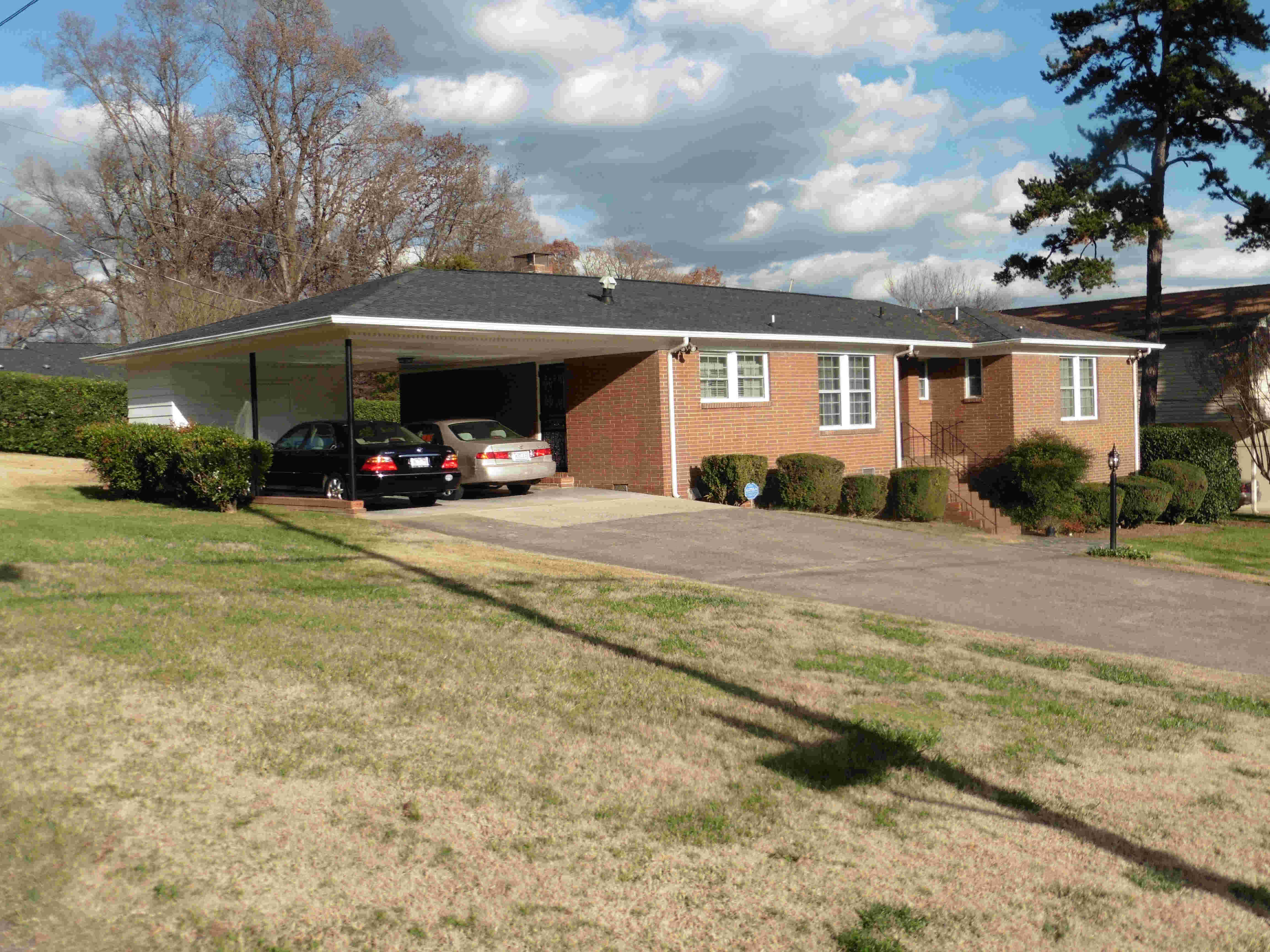1616 Patton Avenue
 Built about 1959 and first occupied by Elizabeth Schmoke Randolph, who became a trailblazing women in top leadership at Charlotte Mecklenburg Schools during the 1960s – 1970s, and her husband John D. Randolph, maintenance supervisor at Charlotte’s Brookhill Village low-income housing development. Elizabeth “Libby” Randolph was Principal at University Park Elementary when the couple moved here. During the 1960s as a CMS administrator she launched kindergarten classes across the school district. She rose to become Assistant Superintendent in the 1970s, the first African American female to co-lead the district, and was celebrated as WBT Woman of the Year — the city’s highest honor. The main building of the Charlotte Mecklenburg Schools administrative campus is named in her memory.
Built about 1959 and first occupied by Elizabeth Schmoke Randolph, who became a trailblazing women in top leadership at Charlotte Mecklenburg Schools during the 1960s – 1970s, and her husband John D. Randolph, maintenance supervisor at Charlotte’s Brookhill Village low-income housing development. Elizabeth “Libby” Randolph was Principal at University Park Elementary when the couple moved here. During the 1960s as a CMS administrator she launched kindergarten classes across the school district. She rose to become Assistant Superintendent in the 1970s, the first African American female to co-lead the district, and was celebrated as WBT Woman of the Year — the city’s highest honor. The main building of the Charlotte Mecklenburg Schools administrative campus is named in her memory.
The second longtime resident in this house was Rosemary Lawrence, Revenue Manager for the City of Charlotte.
*****
Elizabeth “Libby” Schmoke Randolph grew up in a remarkable family. Her father John Hagan Schmoke saved enough on a carpenter’s wages to raise six children, four of whom went to college.[1] In particular, her brother Murray Schmoke “graduated from Morehouse College in 1949 and became a civilian chemist for the U.S. Army at the Edgewood Arsenal and the Aberdeen Proving Ground,” according to a 1991 story in the Baltimore Sun. Murray’s son Kurt (Libby’s nephew), the newspaper went on, “was a star quarterback in high school; a Rhodes Scholar in college; a clean-cut young federal prosecutor who shocked the [Baltimore] political establishment, first … with a successful, grass-roots, outsider’s campaign for state’s attorney and then, with a similar campaign for mayor in 1987.” [2] Kurt Schmoke won election as Baltimore’s first Black mayor and served twelve years until 1999.
For young Libby, however, the most influential family member was her mother Pearl Johnson Schmoke. “My mother was a teacher and I was her oldest child,” Randolph later remembered. “She told me she wanted me to be a teacher, too.”[3] In Charlotte historian Mary Kratt’s book New South Women, Randolph dug deeper into those memories. “All six Schmoke children grew up knowing they were going to college. She taught out in the county, and when she came home, we had dinner, then we got out our books and our homework and sat around the table and studied.”[4]
The family lived in Raleigh, North Carolina, where Shaw University was close at hand. Shaw ranked among the best Black educational institutions in the South. It had been the first to achieve university status, in 1873, and was known for pioneering offerings in medicine and law. In the 1960s, NAACP leader Ella Baker would make the university a training ground for what became the Student Non-Violent coordinating Committee. Through all of that, Shaw set its main task as training teachers. Libby enrolled amid the Great Depression of the early 1930s, paying her tuition in part with money earned playing piano in church.[5] In 1936, the national Black newspaper the Pittsburgh Courier caried a photo of the school’s top senior, solemn-faced in her cap and gown, with the caption “Miss Elizabeth G. Schmoke graduated magna cum laude, highest honor student.”[6] She would later earn a Masters degree from University of Michigan, taking classes during her summer breaks.
Like her mother, she went out to teach in rural and small-town schools – taking positions first in the mountains of Rutherford County, then in the village of Wake Forest, then in the small city of Burlington.[7] “The entire community looked up to the teacher,” she later recalled. [8] In 1944 the energetic superintendent in Charlotte, Dr. Elmer Garinger, hired her to come to the state’s largest city.[9] At West Charlotte High, she quickly became a beloved teacher of English, also supervising the drama program and Student Council. She went back to school herself as one of the first Black graduate students in the School of Education at UNC Chapel Hill where she earned the Advanced Certificate in School Administration in 1958, the gateway credential to become a principal. [10]
Later that year, Dr. Garinger tapped Randolph to be the founding principal at the new University Park Elementary School. Today it is hard to grasp the importance that the position of school principal held in the era of segregation. African Americans ran no public agency nor any corporate office, so to be a principal in charge of a school’s budget, its physical plant and its roster of teachers was to be one of Charlotte’s top Black executives.
In 1959 she and husband John took out the permit to build a handsome house at 1616 Patton Avenue in McCrorey Heights.[11] The neighborhood, developed by Black college president Rev. H.L. McCrorey, was home to many of Charlotte’s African American doctors, ministers, educators and other professionals during the decades after World War II. She and John Daniel Randolph had wed in 1950 in a ceremony covered in detail by the Pittsburgh Courier. He was an electrical engineer, then working for Union Trust Company in his hometown of Rochester, New York.[12] He followed his bride to Charlotte, where he organized the maintenance operations at the huge new Brookhill Village, an apartment complex developed for blue-collar Black families.[13] He passed away in 1963.[14]
In 1964 U.S. President Lyndon B. Johnson launched the War on Poverty, which aimed to use government to better the lives of poor Americans, especially in the South. LBJ’s 1965 Elementary and Secondary Education Act (ESEA) for the first time sent Federal dollars to local public schools. Charlotte decided to use some of the money for kindergarten classes, then a rarity in America. Elizabeth Randolph became the point person for CMS, adding kindergartens first to low-income schools, then to most Charlotte elementary schools.[15] Between 1967 and 1973 the school system went from having a single kindergarten at Davidson Elementary School to having 41 classes throughout the county. The Charlotte initiative became a model for statewide implementation of kindergartens across North Carolina during the 1970s.
Being in the CMS central office was, in itself, a milestone, she later recalled to historian Kratt: “Under segregation, Black persons didn’t even go to the central office unless they were janitors.”[16] Over the years her responsibilities in CMS administration increased. She directed the Title I program, the new ESEA funding stream that aided low-wealth schools. Later she became the curriculum chief for the school system. She gained a national reputation, the first Black woman elected President of the 30,000 member Association for Supervision and Curriculum Development.[17]
During the 1970s, the national Civil Rights spotlight focused on Charlotte, thanks to the 1971 Supreme Court decision in Swann v Mecklenburg Schools. Charlotte implemented an energetic program of busing to create racial balance in every school. At the height of those efforts, CMS fired its superintendent and put a four-person team in charge for the 1976 – 1977 school year as it sought a new chief. Elizabeth Randolph was one of the four — the first African American female in top leadership at CMS. “She was one of those who really spearheaded integration in the schools.” the Charlotte Observer quoted white principal Bob Davis as saying years later. “I don’t believe that integration would have been so successful without her.”[18]
Outside of work, she gave generously of her time to what would now be called “community-building.” She was active in Charlotte’s teachers’ association, which connected educators beyond the classroom – serving as president of the African American branch of the organization during the early 1950s.[19] She took delight in recruiting members to the YWCA. She served for many years on the Y’s local board, involved initially in the segregated Black branch named in honor of poet Phyllis Wheatly, and later in the integrated institution.[20] She especially cherished her involvement in Alpha Kappa Alpha sorority. Sororities and fraternities played a big role in community life – long after college – for African Americans. “Graduate chapters” were a way for well-educated adults to connect and work together to create social events and civic projects. In 1963 for example, as AKA’s local Program Director, she organized seventy-five of her sorors in a “Mecklenburg County Stay-In-School Committee” which provided summer educational experiences and one-on-one coaching in study habits to discourage drop-outs.[21] Over the years she held many local and regional offices in the sorority, including Mid-Atlantic Regional Director and also National Parliamentarian.[22]
Elizabeth Randolph died in 2004 at age 87 but her legacy lived on. [23] An African American Album: The Black Experience in Charlotte Mecklenburg, a book of vintage photographs that she edited for the Charlotte Mecklenburg public library in 1993, continued to be a much-consulted resource; in 2006 the library updated it as Thriving in the Shadows with additional content by journalist Fannie Flono. [24] In 2017 CMS announced it would name the main office tower at its new administrative headquarters in Randolph’s honor. [25] A news article the same year called attention to the philanthropic fund that Randolph established 1993. Now known as the African American Community Fund, incorporating bequests from Randolph and early twentieth century Black entrepreneur Lethia Jones Henderson, it disburses tens of thousands of dollars annually. Projects include Freedom School Partners, which brings summertime education opportunities to students at sites across Mecklenburg – work that Ms. Randolph would surely be personally involved in if she were here today.[26]
At Elizabeth Randolph’s death in 2004, the Charlotte Observer wrote an extensive editorial of appreciation. “Mrs. Randolph life is a sterling example of a life well-lived. Her impact is broad and deep,” the Observer concluded. “This community is lucky to have reaped the benefits.” [27]
******
When Libby Randolph left this house toward the end of her life, Rosemary Lunn Lawrence and her husband James E. Lawrence, Jr., (who passed away shortly after moving in) became the second long-time owners. James Lawrence was the church administrator at Charlotte’s large Friendship Missionary Baptist Church. Rosemary Lawrence, a 1969 graduate of JCSU, had worked in banking before joining the City of Charlotte as its first Revenue Manager, 1985 – 2009. She also was active in community service including:
- Volunteer Coordinator for Friendship Community Development Corporation, the non-profit arm of Friendship Missionary Baptist Church, which built housing for low-income “women in transition” off Beatties Ford Road in the 2000s.http://www.friendshipcdc.org/board.htm Also http://www.charlotteobserver.com/news/local/community/explorers/article23025525.html
- Founding member of Charlotte’s second AKA sorority chapter in 1989, known for its civic activism.http://rhopsiomega.org/rho-psi-omega-chapter/history
- Lawrence’s adult daughter Kamaria Lawrence, who lived in this house, worked as a paid organizer in the Presidential campaign of Hillary Clinton, 2016. https://my.ofa.us/page/event/detail/phonebank/gsfvhj
[1] “Kurt Schmoke’s Family Always Emphasized the Education of the Children,” Baltimore Sun, July 31, 1991. On-line at: https://www.newspapers.com/image/376715080/
[2] “Kurt Schmoke’s Family Always Emphasized the Education of the Children,” Baltimore Sun, July 31, 1991. On-line at: https://www.newspapers.com/image/376715080/
[3] “Memorial Service for Mrs. Elizabeth Schmoke Randolph, Sunday, December 18, 2004,” funeral program on line at https://mccrorey.historysouth.org/wp-content/uploads/2017/06/Randolph_Elizabeth_Schmoke.pdf
[4] Mary Norton Kratt, New South Women: Twentieth Century Women of Charlotte, North Carolina (Public Library of Charlotte and Mecklenburg County, 2001), pp. 182 – 184.
Kratt drew upon an earlier interview: Elizabeth Schmoke Randolph, 1993 oral history with Jennifer Greeson in the collection of Special Collections, Atkins Library, UNC Charlotte. Transcript and audio on-line at:
https://repository.charlotte.edu//islandora/object/uncc:1477 (transcript, part 1 of 2)
https://repository.charlotte.edu/islandora/object/uncc%3A1458 (audio, part 1 of 2)
https://repository.charlotte.edu//islandora/object/uncc:1478 (transcript, part 2 of 2)
https://repository.charlotte.edu/islandora/object/uncc%3A1479 (audio, part 2 of 2)
Also consult Elizabeth Schmoke Randolph, oral history with Rhonda Mawhood for “Behind the Veil” project, Duke University Archives. Audio is on-line at: http://library.duke.edu/digitalcollections/behindtheveil_btvnc02044/
[5] “Other’s Helper: Urban League to Honor Pioneering Educator,” Charlotte Observer, March 10, 1996. https://www.newspapers.com/image/628017984/
[6] “Scenes at Shaw Commencement,” Pittsburgh Courier, June 27, 1936.
[7] Taught in Wake County Schools: “County Teachers Named for Coming School Year,” Raleigh News and Observer, August 16, 1939.
[8] Mary Norton Kratt, New South Women: Twentieth Century Women of Charlotte, North Carolina (Public Library of Charlotte and Mecklenburg County, 2001), pp. 182 – 184.
[9] “Memorial Service for Mrs. Elizabeth Schmoke Randolph, Sunday, December 18, 2004,” funeral program on line at https://mccrorey.historysouth.org/wp-content/uploads/2017/06/Randolph_Elizabeth_Schmoke.pdf
[10] “Memorial Service for Mrs. Elizabeth Schmoke Randolph, Sunday, December 18, 2004,” funeral program on line at https://mccrorey.historysouth.org/wp-content/uploads/2017/06/Randolph_Elizabeth_Schmoke.pdf
[11] “1616 Patton Avenue,” on the McCrorey Heights: HistorySouth.org website. On-line at https://mccrorey.historysouth.org/1616-patton-avenue/ “McCrorey Heights: Making History in An African American Neighborhood,” February 8, 2022, on-line at: https://charlottenc.gov/planning/HistoricDistricts/Documents/McCrorey_Heights_LocalDistrictDesignationReport_Draft.pdf
[12] “Miss Schmoke Married in Brilliant Ceremony,” Pittsburgh Courier, June 24, 1950.
[13] The complex was developed by local real estate leader C.D. Spangler using FHA 608 funding subsidies. Construction stated in Fall of 1950. “$2 Million Negro Housing Job Begins Thursday,” Charlotte Observer, October 31, 1950.
[14] “J.D. Randolph,” funeral notice, Charlotte News, December 5, 1963.
[15] “Deposition of Elizabeth S. Randolph,” 1973, for Swann v. Mecklenburg. Julius Chambers Papers, Special Collections, UNC Charlotte. [Contains detailed information about Randolph’s work in establishing kindergartens] On-line at https://repository.charlotte.edu/islandora/object/mss%3A59661/pages?display=grid
[16] Mary Norton Kratt, New South Women: Twentieth Century Women of Charlotte, North Carolina (Public Library of Charlotte and Mecklenburg County, 2001), pp. 182 – 184.
[17] “Memorial Service for Mrs. Elizabeth Schmoke Randolph, Sunday, December 18, 2004,” funeral program on line at https://mccrorey.historysouth.org/wp-content/uploads/2017/06/Randolph_Elizabeth_Schmoke.pdf Elizabeth Schmoke Randolph,” obituary in the Charlotte Observer, December 15, 2004. https://www.newspapers.com/image/631088191/
[18] “Elizabeth Randolph,” Charlotte News, April 23, 1982.
[19] “Orientation Program Set for City’s New Teachers,” Charlotte News, August 6, 1952. “Teachers Map Year’s Plans,” Charlotte Observer, October 10, 1952.
[20] “YWCA Branch Seeking 1500 New Members,” Charlotte Observer, April 4, 1952.
[21] “Charlotte Women Battle Drop-Out Problem,” Charlotte News, November 7, 1963.
[22] “Sorority Plans Year’s Events,” Anderson Independent-Mail, November 5, 1975.
[23] “Elizabeth Schmoke Randolph,” on the Wikipedia website, https://en.wikipedia.org/wiki/Elizabeth_Schmoke_Randolph
[24] Elizabeth S. Randolph, editor, An African American Album: The Black Experience in Charlotte Mecklenburg (Public Library of Charlotte and Mecklenburg County, 1993). On-line at: https://www.cmstory.org/exhibits/african-american-album/african-american-album
Fannie Flono, Thriving in the Shadows: The Black Experience in Charlotte and Mecklenburg County (Charlotte, Novello Festival Press, 2006.)
[25] “She Broke a Racial Barrier at CMS. Now the Community Says Thanks.” Charlotte Observer, February 16, 2017. On-line at: http://www.charlotteobserver.com/news/local/education/article133131684.html
[26] “Long After Their Deaths, Two Visionary Women Continue to Shape Charlotte Through Their Giving,” Q City Metro website, August 4, 2017. On-line at: https://qcitymetro.com/2017/08/04/httpswww-fftc-org/ Angela Lindsay, “Promoting the Power of Philanthropy,” Pride Magazine, September 26, 2019. https://www.pridemagazineonline.com/promoting-the-power-of-philanthropy/ Ken Garfield, “Building on a Legacy of Black Giving,” on the Foundation for the Carolinas website, August 18, 2021.https://philanthropyfocus.org/building-on-a-legacy-of-black-giving/
[27] “A Life Well-Lived: Educator Libby Randolph Set Bar High for Civic Service,” Charlotte Observer, December 16, 2004.


Architecture
One-story brick ranch house with low hip roofs. The main roof extends to the west wide, creating a two-vehicle car port. The second long-time owners installed larger windows, taking care to make the changes indistinguishable except to the trained eye.
obituary
1959 – John D. Randolph & Elizabeth G.
He: Maintenance man, Brookhill Village Apts.
She: Principal, University Park Elementary School
City directory collection, Robinson-Spangler Carolina Room, Charlotte Mecklenburg Library.
Resources
“Deposition of Elizabeth S. Randolph,” 1973, for Swann v. Mecklenburg. Julius Chambers Papers, Special Collections, UNC Charlotte. [Contains detailed information about Randolph’s work in establishing kindergartens] On-line at: http://digitalcollections.uncc.edu/cdm/search/collection/p16033coll7/searchterm/Deposition%20of%20Elizabeth%20S.%20Randolph/order/nosort
“Kurt Schmoke’s Family Always Emphasized the Education of the Children.” Baltimore Sun, July 31, 1991. On-line at: http://articles.baltimoresun.com/1991-01-31/news/1991031067_1_schmoke-family-history-black-kids
“Long After Their Deaths, Two Visionary Women Continue to Shape Charlotte Through Their Giving,” Q City Metro website, August 4, 2017. On-line at: https://qcitymetro.com/2017/08/04/httpswww-fftc-org/
Randolph, Elizabeth S., editor, An African American Album: The Black Experience in Charlotte Mecklenburg (Public Library of Charlotte and Mecklenburg County, 1993). On-line at: http://www.cmstory.org/african-american-album
Randolph, Elizabeth Schmoke, oral history for “Behind the Veil” project, Duke University Archives. Audio is on-line at: http://library.duke.edu/digitalcollections/behindtheveil_btvnc02044/
Randolph, Elizabeth Schmoke, 1993 oral history in the collection of UNC Charlotte. Transcript and audio on-line at: http://nsv.uncc.edu/interview/mura0047
“She Broke a Racial Barrier at CMS. Now the Community Says Thanks.” Charlotte Observer, February 16, 2017. On-line at: http://www.charlotteobserver.com/news/local/education/article133131684.html